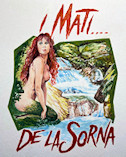 Voluntary citizens' group
Voluntary citizens' group
"I mati dela Sorna" of Brentonico
No address or telephone number
Please refer to the author
(logo by Aldo Ripamonti)
 Voluntary citizens' group
Voluntary citizens' group
"I mati dela Sorna" of Brentonico
No address or telephone number
Please refer to the author
(logo by Aldo Ripamonti)
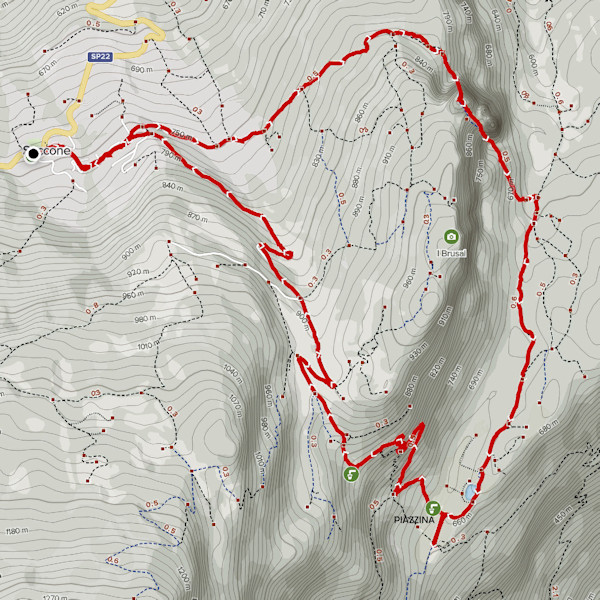
The route follows roads and paths that are well trodden and included on maps, although not marked. The only unknown path is the ancient Senter dela scaleta, used for millennia by hunters and woodcutters and the only link between Saccone and Saiori. Park at the Saccone cemetery and walk through the village to a crossroads with signs. Take Via Furlani to the left and follow it to its end. Climb up the dirt road for a long time, always in an easterly direction, until you reach a shoulder where you can see the valley below is visible. Here there is a stone plaque engraved with the initials LL, the place is improperly called 'Cros del por Vigioti' on maps.
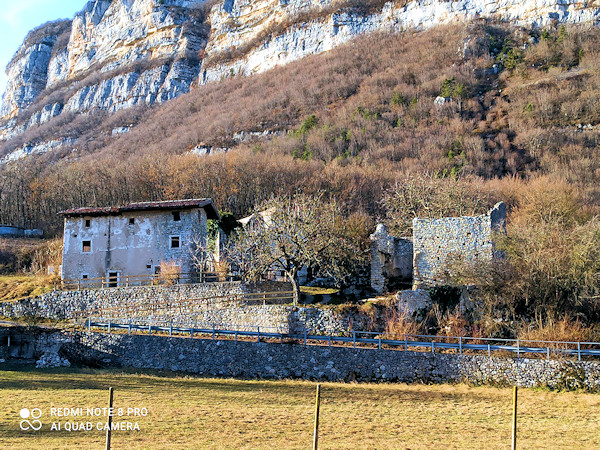
Saiori village today completely uninhabited
One descends the old Senter dela scaleta, which is sometimes steep and has a bumpy surface, until one reaches the dirt road that leads from the Village of Saiori to Piazzina. After about 200 metres the road flattens out and on the left is a horizontal rock plate barred by a large boulder. The place is called 'Lasta del lof' because the figure of a wolf, sometimes covered by vegetation, is engraved on the slab. The Lof was a legendary animal with the body of a man and the head of a wolf and was evoked in the Middle Ages when children threw tantrums: "Vara che ciamo el lof!". Continuing along the road towards the SOUTH, you reach the locality of Piazzina. The land has been restructured, with dubious environmental sensitivity, and is now almost entirely planted with vines.
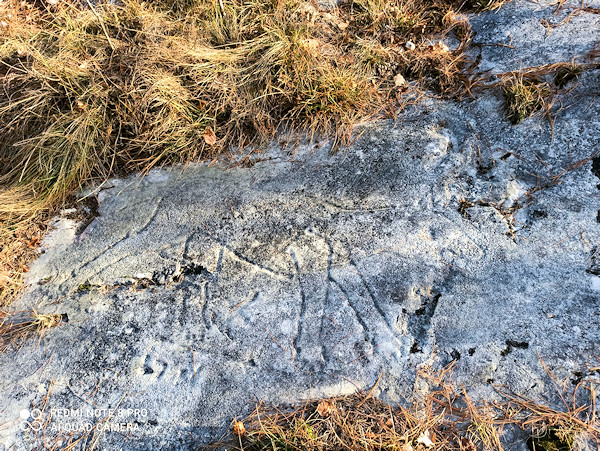
The lasta of the Lof, a mythical half-man, half-wolf animal (the engraving is presumed to be by the famous Belesai)
Before arriving at the house, a small diversion of 100 metres to the left leads to an old capital, where the path to Pilcante. Proceeding a few metres on the meadow in front, it is possible to enjoy the view of the Adige Valley and the town of Ala. Continuing uphill after the house, there is a former military road that leads, after a strenuous climb, to the locality of Fontane. A spring pours into an old drinking trough now covered by vegetation. Continuing along the road towards the NORTH, one soon reaches Localita' Pozza, where holiday homes have been converted from the barracks of the First World War. Descending through the Val dei Berti, through a typical alpine environment of Trentino, you reach the village of Saccone again.
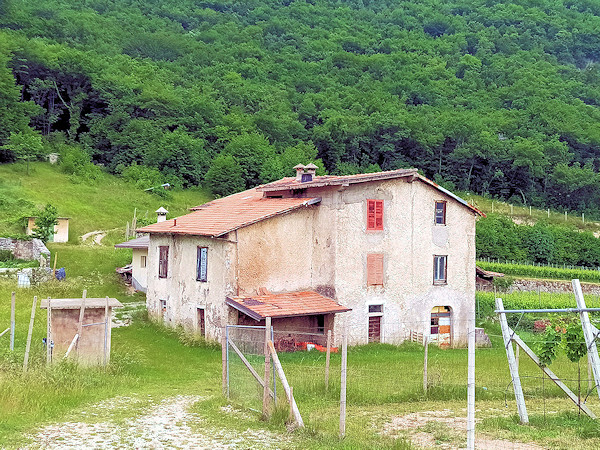
The old Piazzina farmstead was a military barracks during the war
Let us start with the events of the First World War (1915-1918) because the earlier stories have little foundation. It is assumed the locality was supposedly owned by the Counts of Castel Barco like the castle of Saiori, but certain documents have been lost in the great oblivion of history. During the First World War, Piazzina was of considerable strategic importance: Italian trains reached the station of Ala full of supplies and ammunition, a cable car brought tons of materials to Piazzina and they were stored in the 'Bus del Nono'. It was a tunnel dug into the rock, about 50 metres long and very wide. At night, the supplies left on the back of a donkey to the various fronts above the Val Lagarina and the Valle di Loppio up to Monte Altissimo, the farmstead of Piazzina was a barracks of the Italian command. At the end of the war, Mr Pietro Lorenzini decided to sell his house in Saccone and acquire the Piazzina plateau consisting of around 18 hectares of woods and meadows, he wanted to start a family in this heavenly place. He was in love with a young girl from Saccone named Maria Lorenzini and went to her family to ask for her hand in marriage. Maria's father was the first to advise Pietro against the marriage because of his daughter's poor health and said that he would soon be left without a wife and without children, citing the doubt that the woman could have any, so thin and sickly was she. Pietro (my grandfather) went ahead and married Maria (my grandmother) who had five children and died at the age of 105 years old. The early days were hard for the Lorenzini family but by the time World War II came along, the farm was practically self-sufficient. There was plenty to eat in Piazzina: goats, cows, chickens and Pietro was also a good hunter. The fields produced maize for polenta and even wheat for white flour, in the gardens there were vegetables galore and the vines produced good wine. The five children of Peter and Maria grew up healthy and robust and walked to school in Saccone (one hour's walk).
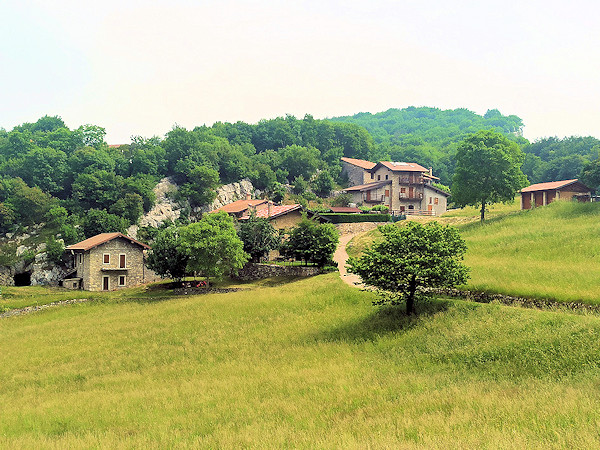
The Pozza village built on the remains of military barracks
After the war the town of Ala was reduced to starvation, Pietro's first daughter was called Nella (my mother) and she went every weeks to the valley to sell eggs, cheese and butter, she was 15 years old. One fine day a noblewoman from Ala did not have the money to pay for the goods, she offered Nella an exchange and gave her an old trumpet gramophone, which Nella immediately put in her rucksack and took home (a 2-hour walk) with some huge 33 vinyl records. Her father Pietro was very angry but Nella liked music and she liked to dance. With that old gramophone, she even organised dance parties on the era (square) of the farm, which were attended by people from Saccone and Corne'. In Piazzina there was a need for labour to restructure the fields, Pietro hired citizens from Ala to build the dry stone walls, and the pay was two slices of polenta a day: one to eat and the other to take home for the family (unfortunately, there was no citizenship income at that time!). Let's fast forward to the sixties because at that time yours truly entered the field too, in fact, at the age of ten, I was hired, during the summer holidays, as a 'famei'. Famei, it sounds like a polite family name, instead they were practically slaves who worked at the master's will, receiving in return room and board and a few lira to buy an ice cream. At that time Piazzina was an isolated farm but flourishing: there were 23 cows in the barn and my grandmother Maria made me count the hens, which numbered 44, including seven guinea hens. However, I learned many things in Piazzina: grazing and milking cows and goats, cultivating the land and vegetables, making butter and cheese, driving a tractor, etc. I also learnt bad things like shooting birds and more, making grappa, setting traps for animals, etc. In the early 1970s, Pietro's four sons decided it was time to change the destiny of Piazzina to make it a large plantation of apples and there began the environmental degradation of what had been paradise on earth. They bought a bulldozer that spied the land and closed the historic 'Bus del nono' for good, they built a pond for water storage and modern irrigation facilities. The apple plantation apples soon turned out to be a total failure, and so they decided to sell the land to those who continued the environmental disruption to build a huge vineyard, while the old farmstead is falling apart. Poor Piazzina, to see it today and remember how it was simply brings tears in the eyes, it still remains a beautiful, half-known isolated place that is well worth a visit.
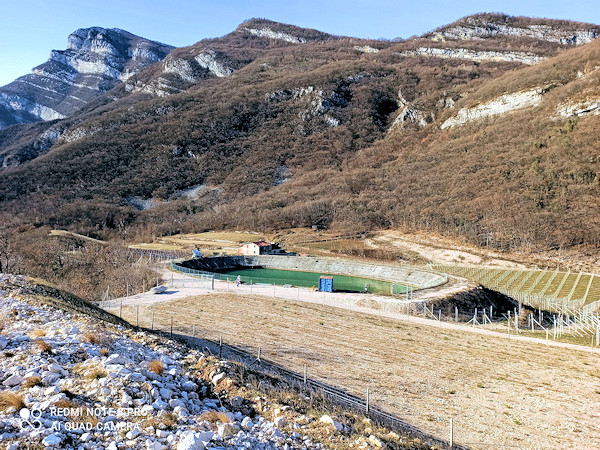
Piazzina today ...
WARNING - The group of volunteer citizens called 'I mati dela Sorna' has worked hard to make the trek as safe as possible. Keep in mind that Monte Baldo is still a mountain and, as with all excursions in an alpine environment, it is not absolute safety cannot be guaranteed.
MONTE BALDO TUTTI I SENTIERI NEL CANYON SORNA - MAP CANYONTREK SORNA
UNKNOWN PATS ON MONTE BALDO - SENTIERI SCONOSCIUTI SUL MONTE BALDO
CORNALE' - BANCHETA - PIGNARI - BRACON - ASENI - SAIORI - PIAGU' - PIAZZINA - ALBI - CROSANO - POLSA - LODRON
SOURCES - From outdooractive.com, you can also download the gpx file of the route.
Web site https://out.ac/I9rKfr
Alltrails.com maps - Delio Zenatti's gps tracks on outdooractive.com